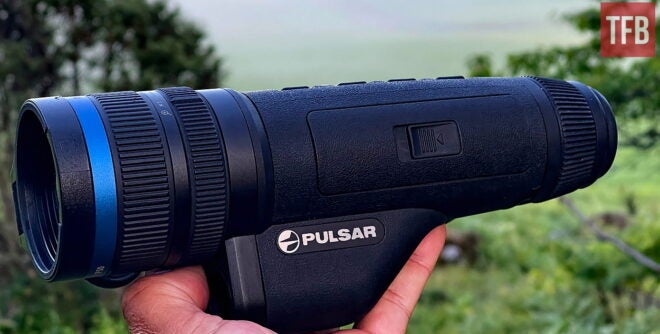The new Pulsar Telos LRF XP50 has been in development for some time and was released at IWA in Germany earlier this year. It takes over where the Pulsar Helion 2 XP50 PRO thermal monocular left, and TFB got a pre-production unit to try out for a few months. Just like its predecessor, the Telos is a high-end thermal monocular, but more or less everything has been changed and upgraded. For instance, the overall body shape, thermal sensor and the ability to use an integrated laser rangefinder.
Pulsar Thermal Imaging @ TFB:
- TFB Review: Pulsar Merger LRF XP50 Thermal Binoculars
- TFB Review: Pulsar Thermion 2 LRF XP50 Pro Thermal Riflescope
- TFB Review: Pulsar KRYPTON FXG50 – The Ultimate Thermal Vision Front Attachment?
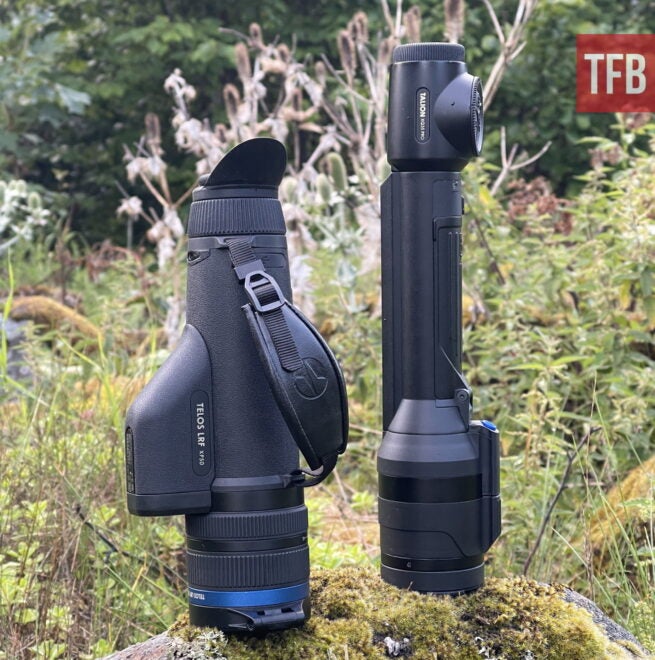
The Pulsar Telos (left) and the new Pulsar Talion XQ35 Pro thermal rifle sight.
Introduction
The Telos LRF XP50 is a highly capable unit, with a high-end approach to more or less everything that can be measured. According to Pulsar, their new Telos is the first thermal imaging device on the market that offers the option of technical upgrades as time goes by, and the owner wishes to upgrade, for instance, the thermal sensor to the latest model.
Overall the Telos LRF XP50 exudes quality and feels like a great choice for any professional. I’m a brave person, so I began my testing by splashing the Telos with water over and over. All of my testings have been done afterwards, with zero issues.
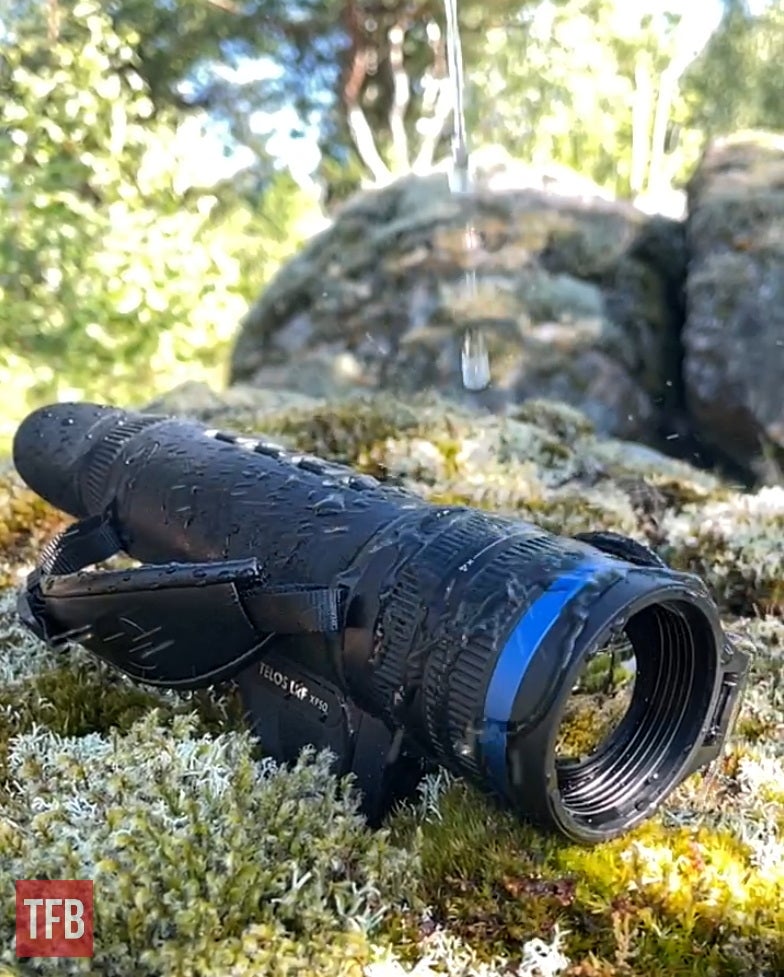
Pulsar probably had a good look at makers of high-end camera objective lenses. The focusing and smooth zoom rings are located just by the lens, and manipulating them feels just right. Possibly, the travel for the zoom ring could have been just a tiny bit shorter. My Canon EOS objective lenses feel very similar. The only thing we don’t get (yet) is auto-focus, but it seems difficult to design such a feature for a thermal.
Technical Specifications
The model tested here is the first model in the new Telos series, and it uses the European-made Lynred thermal sensor with a 640×480 pixel resolution, at 17 microns pixel pitch. The NETD thermal sensitivity is stated at 18 millikelvin, which is the lowest I’ve ever seen on a commercial device. The objective lens is F50 / 1.0, and the magnification goes from 2.5 up to 10 (x4 smooth digital zoom). Ten-power magnification may sound low, but I never experienced a need for more. I have no details, but I make the assumption that Pulsar will offer versions with both higher and lower specifications. The composite polymeric rubber-coated case should be able to accommodate all sorts of sensors, displays and perhaps even other plug-ins in the future?
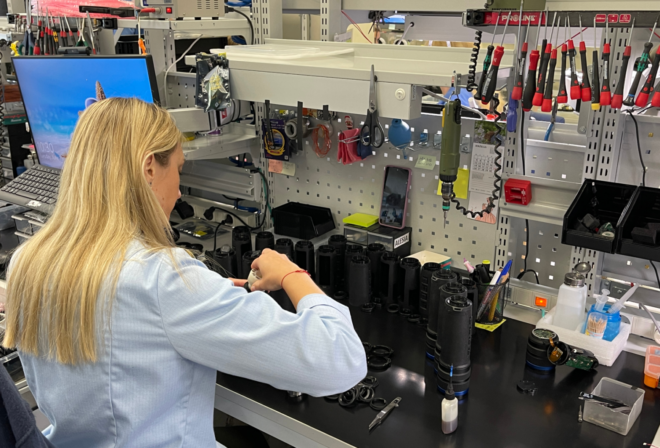
The new Telos on the production line in the factory in Latvia
Image Quality
As mentioned this is a professional thermal monocular with the latest thermal sensor technology. Everything here is of course my subjective impressions, but I do my best to test devices side-by-side with other brands and models under the same or similar conditions. I also let friends (and foes) try, to get a second opinion which blends into my overall perception and conclusion.
I have yet to see a crisper image. The image quality and detail are astonishing. On several occasions, I have managed to sneak up on wild boar, and there’s a ”crispness” and detail in the image I’ve never seen in a thermal device before. At the beginning of the summer we had great weather, it was very dry and it didn’t rain for over a month. Great news for anyone who wants to produce high-quality and impressive footage from thermals.
“They see me, I see them.” Some say you cannot see depth in a thermal device, but with the latest sensor technology, I beg to differ. The better the image, the easier it will be to distinguish males from females, which is quite important at least when hunting in Europe.
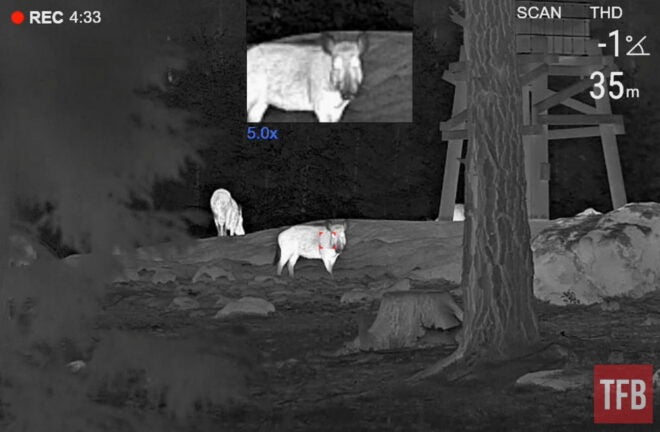
However, this all changed when the weather decided to rain for almost two months. It didn’t rain every day, but it felt like it. Bad news for any thermal, but it gave me lots of opportunities to see how well the Telos LRF XP50 performs when there’s a lot of water in the air. I was quite surprised, as the Telos worked well even when it rained. There’s, of course, quite a deterioration in the image quality as everything out there gets to more or less the same temperature, but I was still able to see details reasonably far out.
Below: I also had a short time with a Telos without the optional LRF.
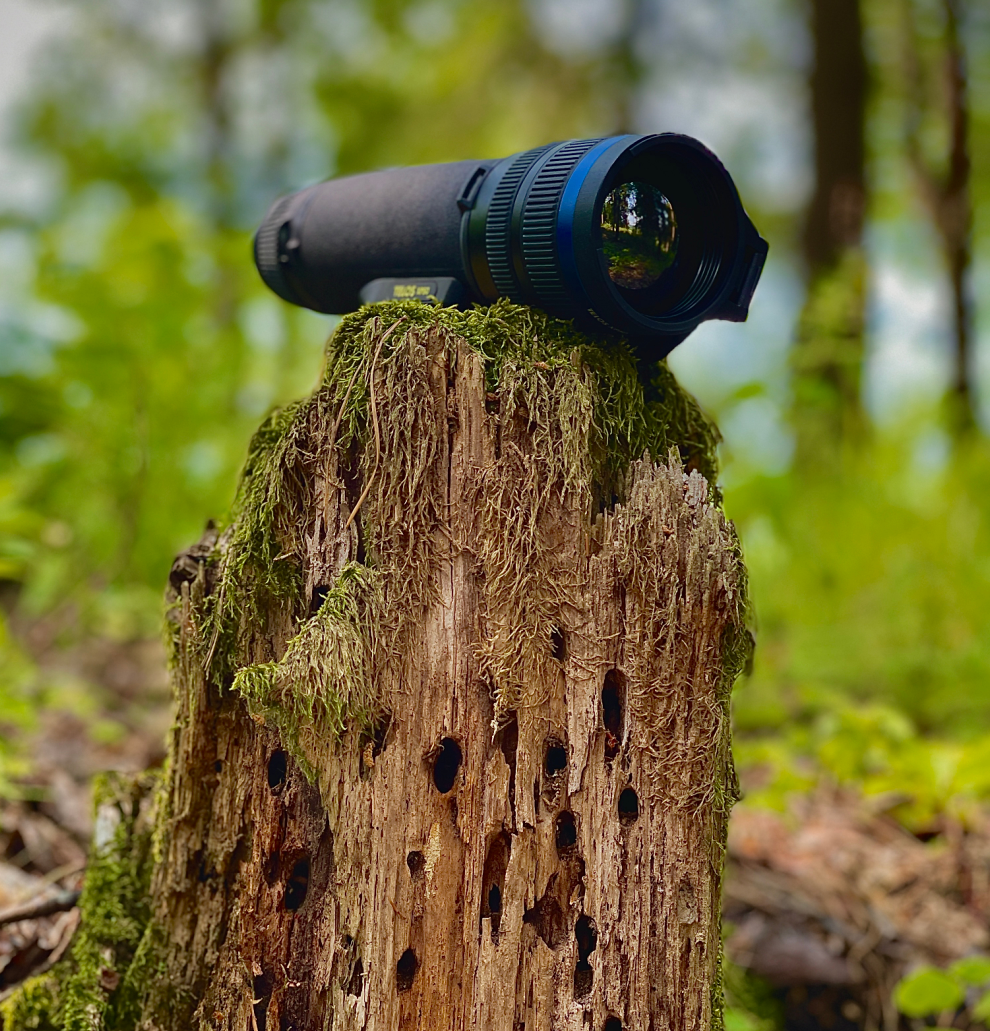
The NETD value, preferably measured on the lens, gives us an idea of how well the thermal can distinguish temperature differences between objects. The value indicates the smallest temperature difference that the camera can detect above the background noise. It measures the sensors’s ability to see tiny variations in heat.
Below: This bird’s nest is about 120 meters away, and the image is taken in full rain just after midnight. It may look boring, but most thermals wouldn’t be able to show much of an image at all under these conditions. If there was anything hot out there it would show very clearly.
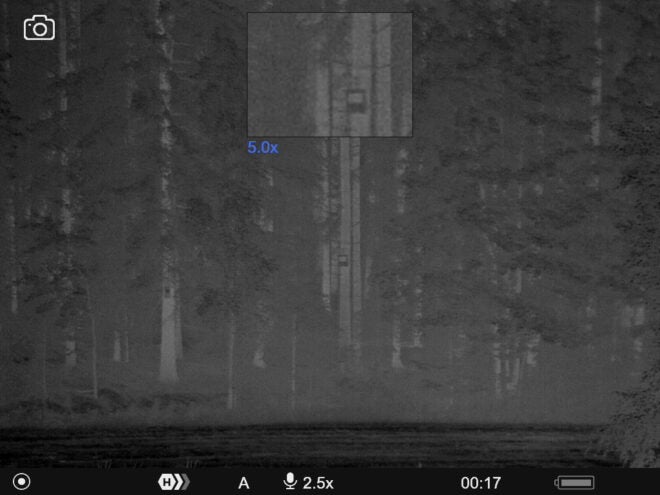
As the fog rose over the field and started to cover everything, I did some more testing. This is quite often the same time as the sun starts to set, and the animals get more active.
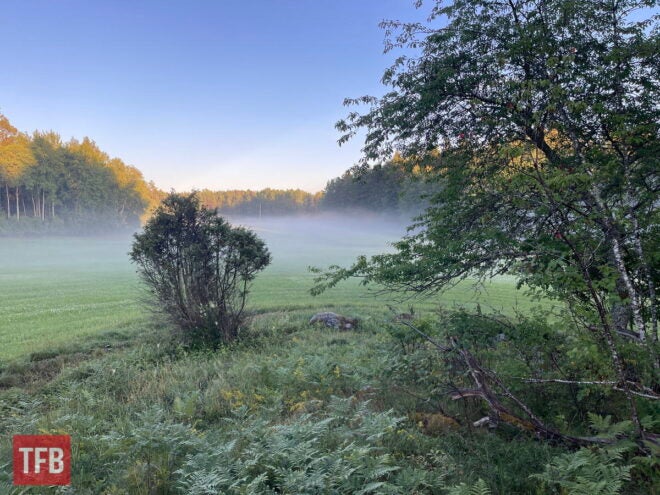
For sure, the Telos LRF XP50 is powerful enough to cut through the fog. These images are of course taken with the iPhone.
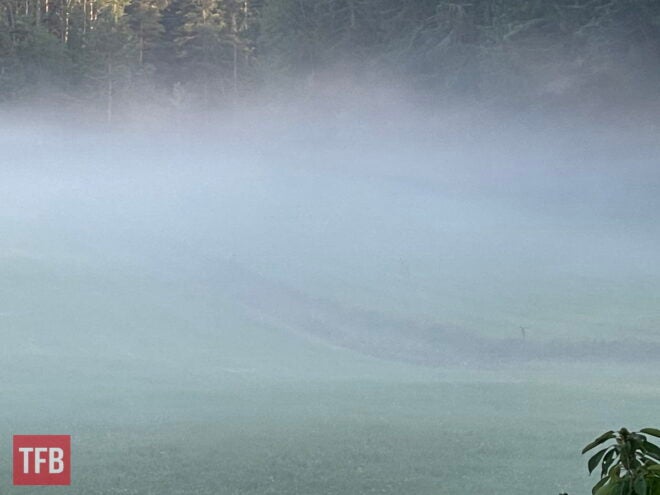
I had a roe buck on a field, at approximately 160 meters covered in fog. Eventually, it was impossible to see him with the naked eye, he completely disappeared in the white-gray. Above you can barely spot him just behind the ditch, mid-right. Thanks to the thermal sensor in the Telos LRF XP50, I could track his every step. The image is taken free-handed, and as usual, this appears much better live than with processed images like this.
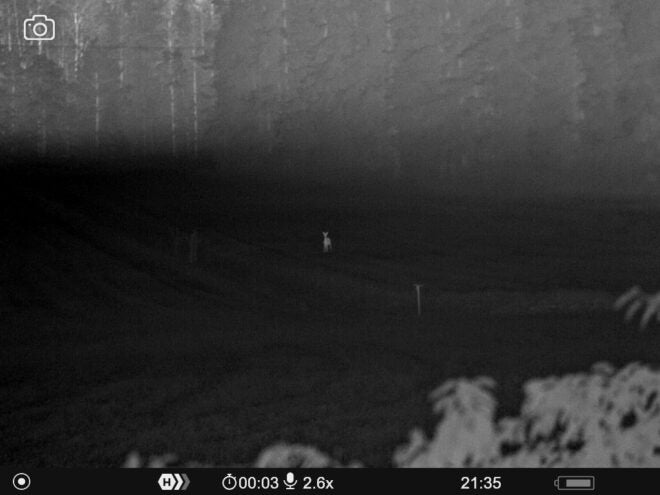
And here with the 10x zoom. The antlers didn’t come out in this image, but when watching live, I could see them.
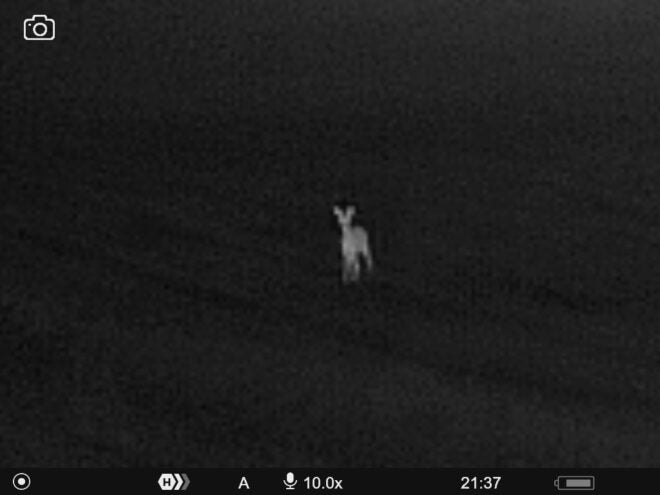
The LRF works great, especially when in scan mode. However, it does not cut through the fog, and occasionally you keep your fingers in front of it by accident.
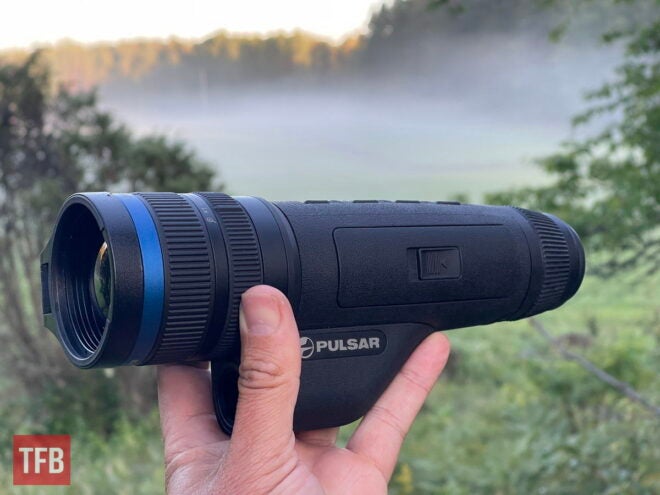
The performance of this device is remarkable. The sensitivity of the new sensor really makes a difference. I have shown my videos and images to a bunch of people, both experienced and beginners, and they all come back with a WOW about how crisp the image detail is. Some said it looked like the pictures were taken indoors.
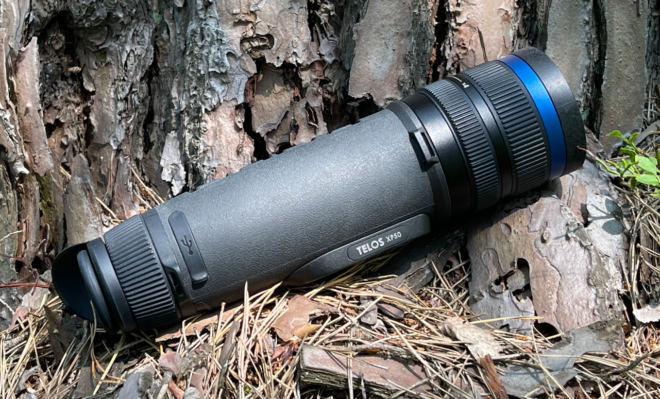
The Telos without the LRF. Note that the LRF is not detachable, but can be retrofitted. There is also an adapter so that you can attach it to a bipod.
“What does it look on four different Pulsar thermals?”
Further testing in the middle of the day, in full sunshine. Reference taken by iPhone, distance about 40 meters.
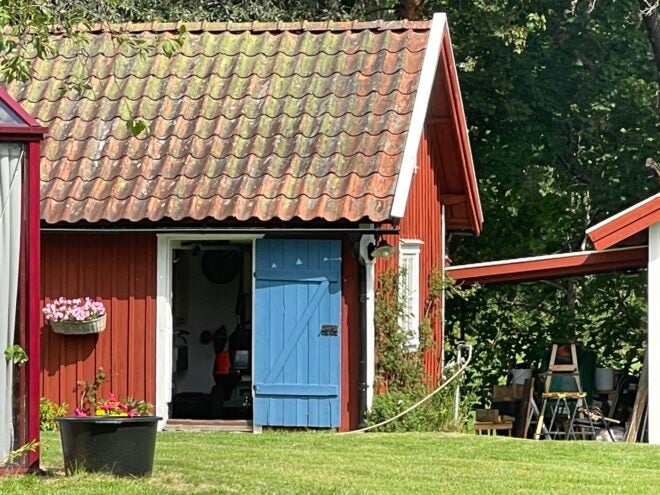
Below: Here is the Pulsar Telos, with the 640×480 pix. @ 17 µm (NETD <18 mK).
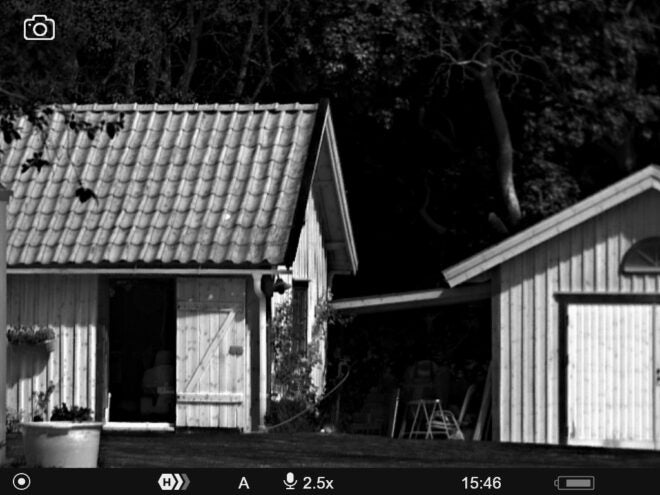
Pulsar Telos, with the 640×480 pix. @ 17 µm (NETD <18 mK)
Below: Since I had the brand new Pulsar Merger XL thermal binoculars with me, I took an image just minutes after for you to compare. The Merger XL has an HD 1024×768 @ 12 µm thermal sensor with a NETD <40 mK. The frame rate is always 50 Hz, so you don’t notice any delay.
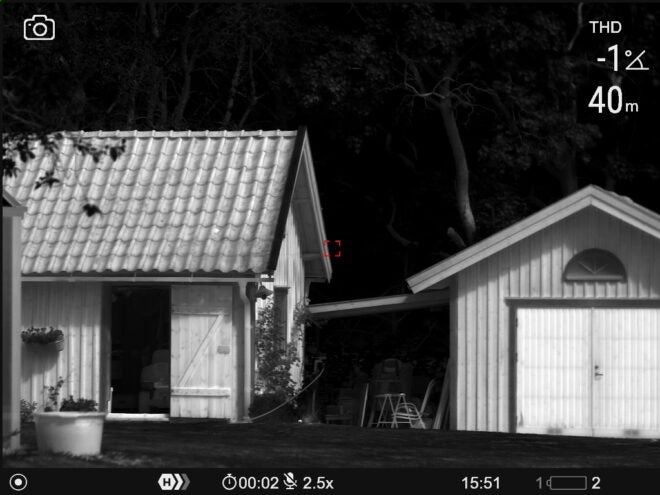
Merger XL with HD 1024×768 @ 12 µm thermal sensor, NETD <40 mK.
You may say that these thermal images are the same, but they are not. The more you look, the more differences you discover.
Below: Here is a still from the brand new Pulsar Krypton 2 FXG50 Thermal Clip-On, taken just minutes apart. This unit uses a Lynred 640×480 @ 12 µm (NETD <40 mK) thermal sensor, F50 / 1.0, and since it’s a clip-on, there’s no magnification and the FOV is different.
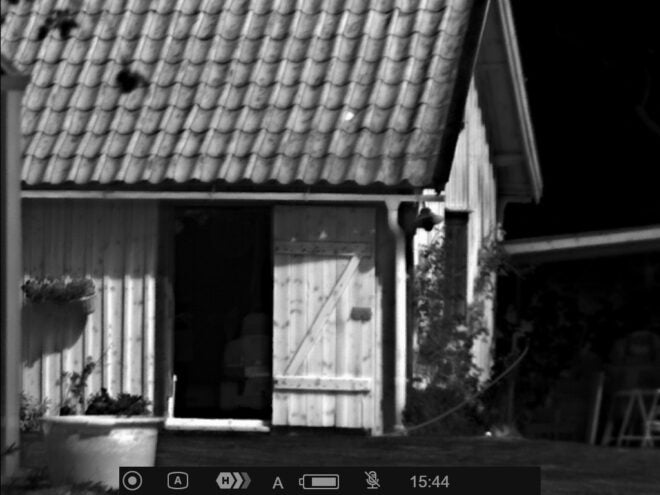
Pulsar Krypton 2 FXG50 Thermal Clip-On
And finally a still from the new Pulsar Talion XQ35 Pro thermal rifle sight, which uses a Lynred 640×480 @ 12 µm (NETD <40 mK), objective lens F35 / 1.0.
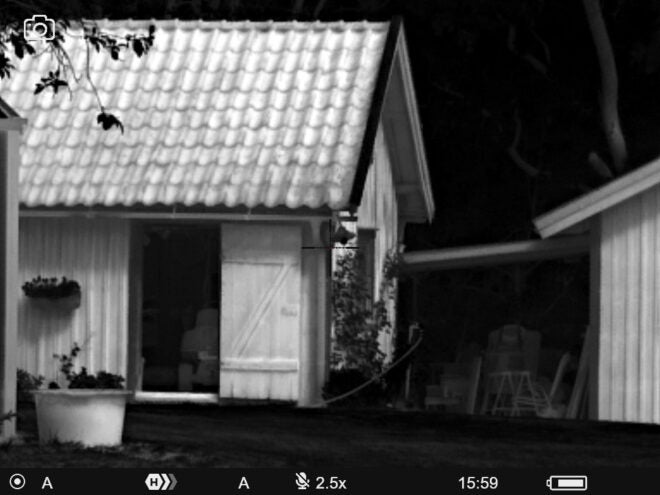
Pulsar Talion XQ35 Pro thermal rifle sight.
Just imagine a marriage between the Merger XL thermal binoculars with the low NETD of the Telos, and we have ourselves some thermal magic.
Batteries and Power
The battery compartment keeps a detachable, custom battery that can be charged either with USB C (on the device or on the battery directly) or wireless. This is the first thermal I’ve ever tried with wireless charging. This feature means little to me personally, but I’m sure it can be that little extra thing for someone, like charging in the car? The battery itself slides in perfectly, and the rubber o-ring seal is ribbed to keep moisture and dirt away.
The new quick-change Li-ion battery offers more than 8 hours of operating time according to the specifications, and although I rarely use thermals for that long the claim seems likely to be true. The bottle is Nemiroff Vodka de Luxe from Ukraine.
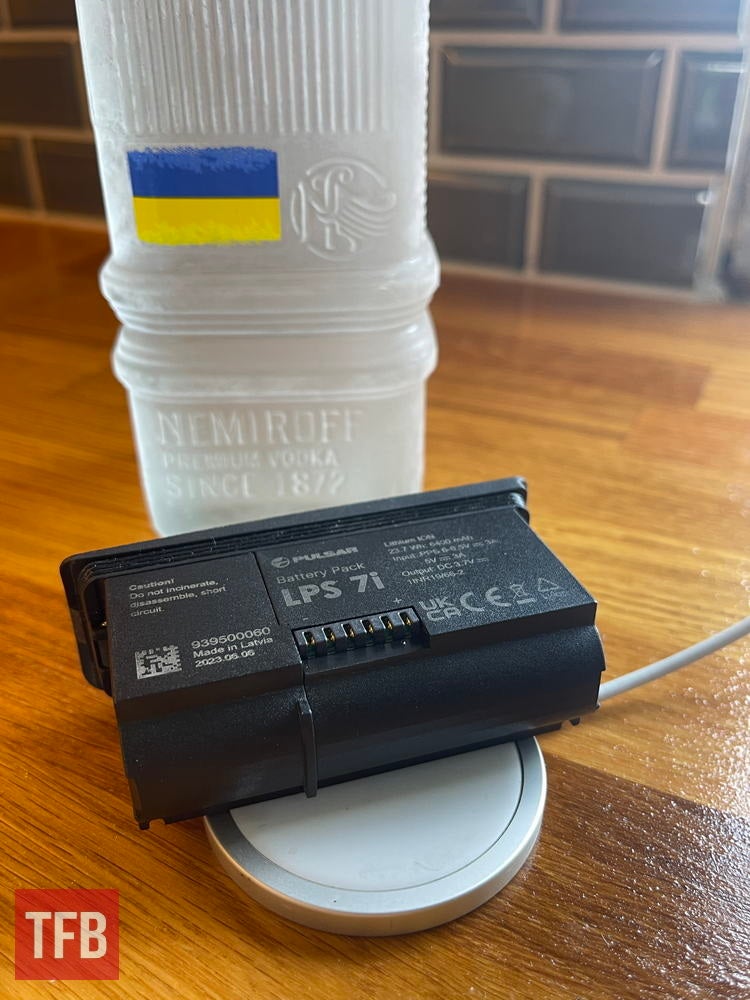
Note the rubber seal to protect the internals from dust and water. An extra battery pack is about €150, so if you need to purchase a spare, it’s not the end of the world.
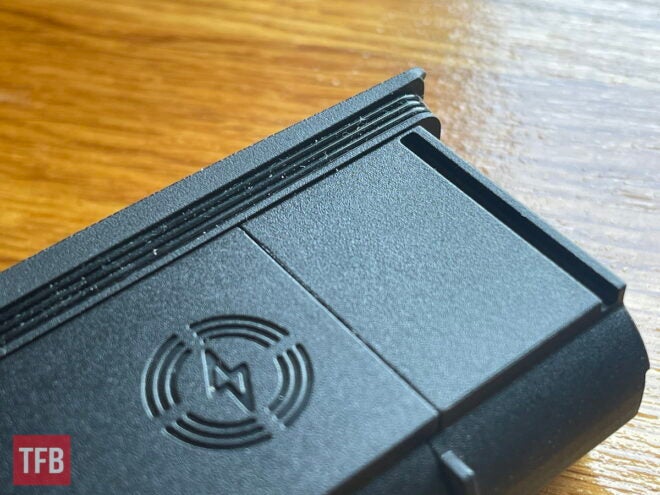
Pulsar Telos LRF XP50 – Sample Images
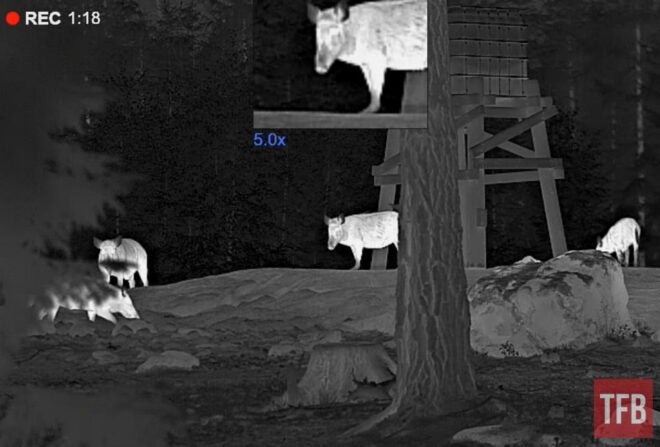
This is about as close as I dare to go, without taking one for the team. Pitch black outside.
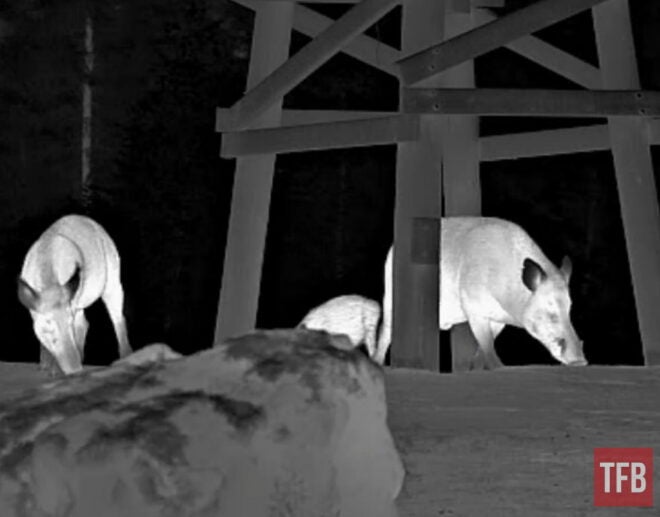
Here’s an excellent example of the depth when hunting at night. Animals from 50 meters up to over 500-600 meters.
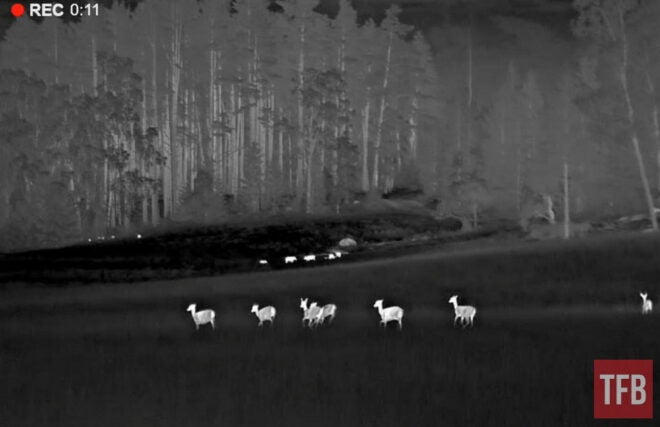
Red deer at 41 meters. These are very impressive animals, like horses with antlers.
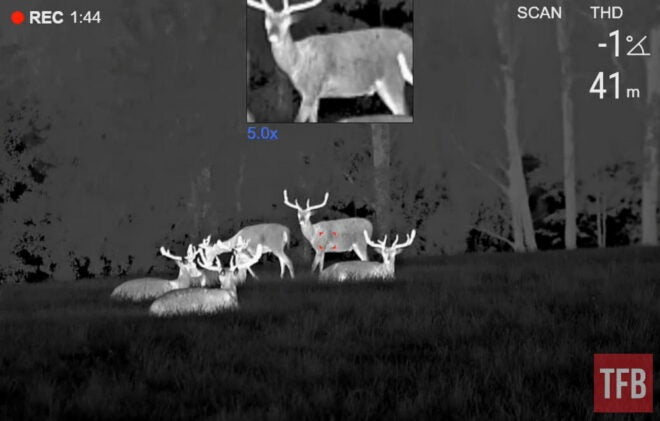
Here’s an excellent example to show what your eyes will see (and not) through an iPhone, versus if you use a thermal imaging device. Thermal imaging unveils the concealment of an animal’s natural camouflage. Overall a cloudy day, with occasional showers.
Can you see and identify the animal(s) in the image below?
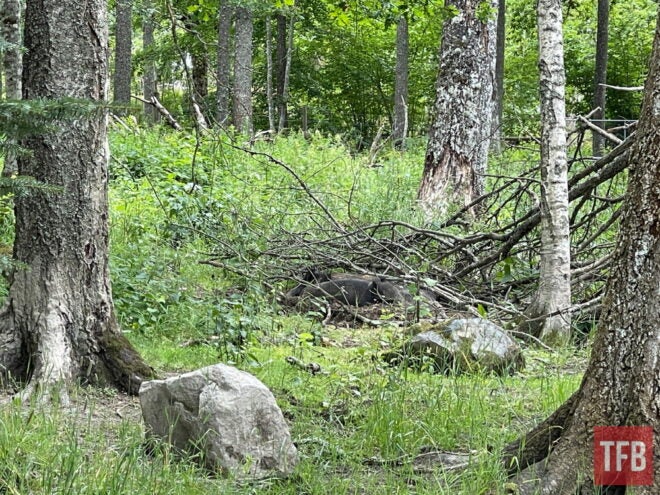
Here is the same view through the Telos. There’s no hiding for warm objects. There are actually no less than three wild boars in their daytime sleeping pit.
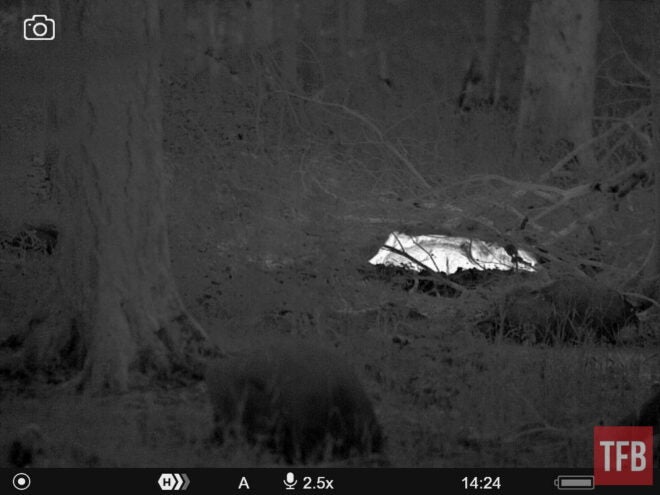
Night time by the wild boar feeder. Notice any activity? (iPhone image)
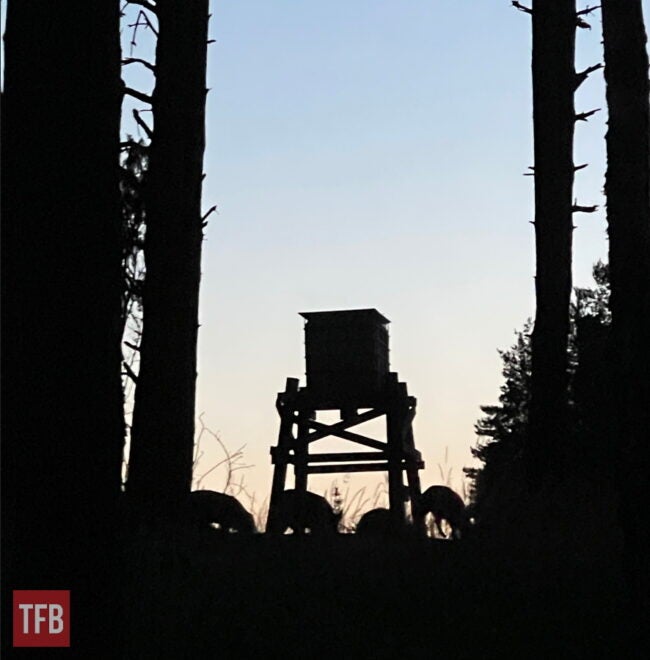
This kind of image quality is the best I have ever seen from a commercial thermal device. Notice the detail in the fur of the wild boar (the thermal is taken from a different angle).
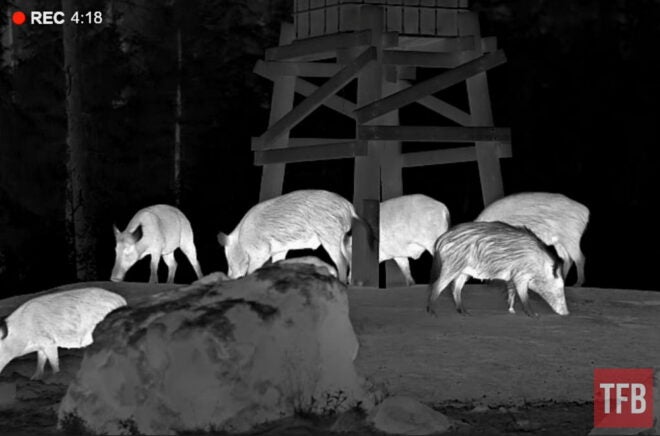
Videos – Pulsar Telos
Here’s an example of wild boar at the feeder. The distance is fairly close and the Telos LRF XP50 is on a tripod for stability, but there’s no “cheating” to get this kind of image quality. Just a normal summer night with clouds, and let Telos’ video function roll. The videos can be downloaded to your phone or pad by WLAN, or by USB C cable to your laptop.
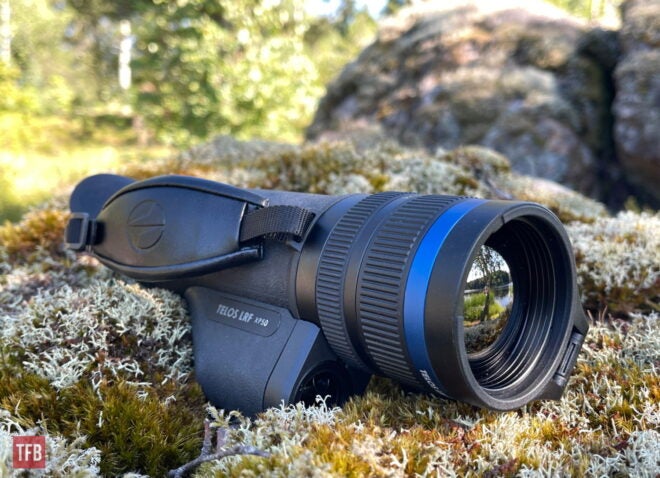
Price and availability
The Pulsar Telos XP50 Thermal Imaging Monocular with LRF seems to cost around €3,690 in Europe. It has just been released in Europe, with limited availability to begin with. In the USA I can only find it on pre-order, but the pricing should be in a similar region.
Conclusion
I think Pulsar will have some challenges in explaining how this device is upgradeable, at least it would take a lot of marketing and help from their resellers. However, this will most likely be a USP (Unique Selling Point) for Pulsar for quite a while, and ”sustainability” is quite important for a lot of customers and hunters.
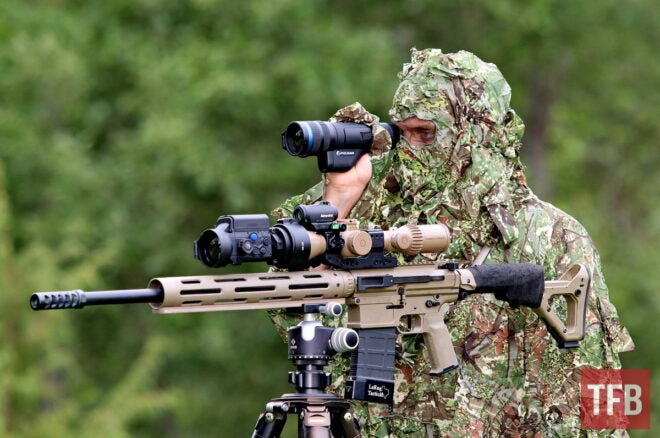
Regardless, it doesn’t change the fact that the Telos LRF XP50 is a great thermal monocular, and is on the top in terms of image quality and overall impression. If you’re a beginner and looking for a thermal on a budget, there are lots of other options. However, if you’re a professional or just appreciate and have the means to buy the best then you should surely take a closer look at the Telos.
Sadly, I have to send this demo unit back. The image quality produced by the Lynred NETD <18 mK sensor will surely be missed.
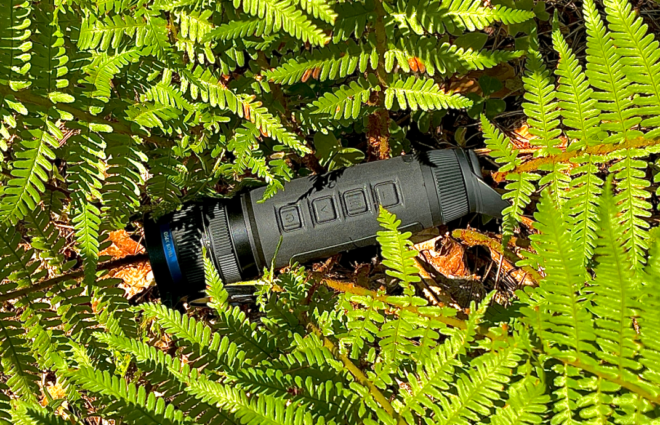
What’s great?
- More or less everything is Made in Europe, including the Lynred thermal sensor. Pulsar even make most of the plastics and the keypad themselves.
- Overall a very competent package.
- It’s upgradeable – it will be quite interesting to follow what Pulsar will offer, but let’s guess at least an HD sensor.
- The thermal image quality is the best money can buy at the moment.
- Very easy to use, while still packing the hottest technology and software available.
- The carrying pouch is the best on the market, you notice that Pulsar spent a lot of time here.
- Quick startup from a cold device, in just seconds. Much faster than most competitors.
What could be better?
- There is no proximity sensor to automatically put the device on standby when it’s not in use.
- It’s easy to “wobble” around when adjusting the focus or the zoom.
- The tactile feel of the buttons could be a little better, but it’s no disaster.
- Don’t put your hand in front of the laser when measuring the distance.
Here’s a direct link to Pulsar’s website page about the Telos.
We are committed to finding, researching, and recommending the best products. We earn commissions from purchases you make using the retail links in our product reviews. Learn more about how this works.
 Your Privacy Choices
Your Privacy Choices
